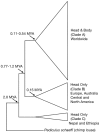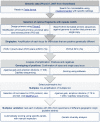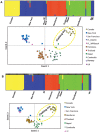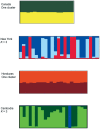Nuclear genetic diversity in human lice (Pediculus humanus) reveals continental differences and high inbreeding among worldwide populations
- PMID: 23460886
- PMCID: PMC3583987
- DOI: 10.1371/journal.pone.0057619
Nuclear genetic diversity in human lice (Pediculus humanus) reveals continental differences and high inbreeding among worldwide populations
Abstract
Understanding the evolution of parasites is important to both basic and applied evolutionary biology. Knowledge of the genetic structure of parasite populations is critical for our ability to predict how an infection can spread through a host population and for the design of effective control methods. However, very little is known about the genetic structure of most human parasites, including the human louse (Pediculus humanus). This species is composed of two ecotypes: the head louse (Pediculus humanus capitis De Geer), and the clothing (body) louse (Pediculus humanus humanus Linnaeus). Hundreds of millions of head louse infestations affect children every year, and this number is on the rise, in part because of increased resistance to insecticides. Clothing lice affect mostly homeless and refugee-camp populations and although they are less prevalent than head lice, the medical consequences are more severe because they vector deadly bacterial pathogens. In this study we present the first assessment of the genetic structure of human louse populations by analyzing the nuclear genetic variation at 15 newly developed microsatellite loci in 93 human lice from 11 sites in four world regions. Both ecotypes showed heterozygote deficits relative to Hardy-Weinberg equilibrium and high inbreeding values, an expected pattern given their parasitic life history. Bayesian clustering analyses assigned lice to four distinct genetic clusters that were geographically structured. The low levels of gene flow among louse populations suggested that the evolution of insecticide resistance in lice would most likely be affected by local selection pressures, underscoring the importance of tailoring control strategies to population-specific genetic makeup and evolutionary history. Our panel of microsatellite markers provides powerful data to investigate not only ecological and evolutionary processes in lice, but also those in their human hosts because of the long-term coevolutionary association between lice and humans.
Conflict of interest statement
Figures






References
-
- Reed DL, Toups MA, Light JE, Allen JM, Flanagin S (2009) Lice and other parasites as markers of primate evolutionary history. In: Huffman MA, Chapman CA, editors. Primate Parasite Ecology: The Dynamics and Study of Host-Parasite Relationships. Cambridge: Cambridge University Press. p. 531.
-
- Nozais J-P (2003) The origin and dispersion of human parasitic diseases in the old world (Africa, Europe and Madagascar). Mem Inst Oswaldo Cruz 98 Suppl 113–19 Available: http://www.ncbi.nlm.nih.gov/pubmed/12687757. - PubMed
-
- Dittmar K, Araújo A, Reinhard KJ (2012) The Study of Parasites Through Time: Archaeoparasitology and Paleoparasitology. In: Grauer AL, editor. A companion to paleopathology. Chichester, West Sussex. Malden, MA: Wiley-Blackwell.
-
- Araújo A, Ferreira LF, Guidon N, Maues da Serra Freire N, Reinhard KJ, et al. (2000) Ten thousand years of head lice infection. Parasitol Today 16: 269 Available: http://www.sciencedirect.com/science/article/pii/S016947580001694X. - PubMed
-
- Burgess IF (1995) Human lice and their management. Adv Parasitol 36: 271–342 Available: http://www.ncbi.nlm.nih.gov/pubmed/7484466. - PubMed
Publication types
MeSH terms
LinkOut - more resources
Full Text Sources
Other Literature Sources
Medical

